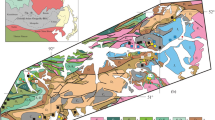Summary
A small Lower Cretaceous igneous province on Jamaica has been assigned an Albian or Aptian age on the basis of the fauna of associated sediments. Despite pronounced tropical weathering, it was possible to find three reasonably fresh lava exposures, paleomagnetic investigations of which suggest that during the Lower Cretaceous period the southern polarity geomagnetic pole, as viewed from Jamaica, was situated in the present day northeast Pacific. An interpretation of this result in terms of plate tectonics yields a movement of the Caribbean tectonic plate over a distance of 1000 km to the northeast since Lower Cretaceous. This result is in good agreement with similar deductions made from previously investigated Upper Cretaceous rocks on Jamaica. It suggests also that no appreciable movement of the Caribbean plate or polar wonder had occurred during the Cretaceous age. One of the three lava units reveals an equatorial direction of magnetization also found previously in Upper Cretaceous rocks of the island. This direction could have been caused by a non axial dipole configuration during a reversal of the geomagnetic field. This interpretation is supported by other evidence of a field reversal at the close of Aptian and beginning of Albian.
Zusammenfassung
Auf Jamaika wurden Vulkanite aus der Unterkreide paläomagnetisch untersucht, die gemäß der Fauna der zugehörigen Sedimente in die albische oder aptische Zeit eingeordnet werden können. Trotz großer Schwierigkeiten mit tropischer Verwitterung, Geländeform und Vegetation konnten Bohrkerne von drei verschiedenen Lavaeinheiten gewonnen werden. Unter Anwendung der üblichen Labormethoden wurde daraus die Paläomagnetfeldrichtung in der Unterkreide bestimmt.
Das Ergebnis kann nach der Theorie der Plattentektonik, so gedeutet werden, daß sich Jamaika mit der gesamten karibischen Platte seit der Kreidezeit um 1000 km nach Nordosten bewegt hat. Ähnliche Resultate wurden bereits früher für die Oberkreide ebenfalls durch eine Untersuchung auf Jamaika gewonnen, welche somit durch die hier vorgelegten, Datenangaben bestätigt wird.
Eine Lavaeinheit ergab eine außergewöhnliche Pollage in äquatorialen Breiten. Derartige Pollagen wurden ebenfalls früher auf Jamaika bei vulkanischen Gesteinen der Oberkreide beobachtet und sind auch bei anderen paläomagnetischen Untersuchungen manchmal festgestellt worden. Das Phänomen wird als „Momentaufnahme” einer geomagnetischen Feldumkehr gedeutet, bei der die Umpolung offensichtlich unter Beibehaltung des Dipolcharakters als eine Art „Umklapp”-Vorgang erfolgt. Für diese Interpretation spricht, daß gerade am Übergang vom Alb zum Apt eine der seltenen Feldumkehrungen der Kreidezeit beobachtet wurde.
Similar content being viewed by others
References
Freeland, G. L., and R. S. Dietz: Plate Tectonic Evolution of Caribbean — Gulf of Mexico Region. Nature232, 20–23 (1971).
Carey, S. W.: A Tectonic Approach to Continental Drift. Symposium on continental drift, Hobart, 177–355 (1958).
Hess, H. H., and J. C. Maxwell: Caribbean Research Project. Bull. Geol. Soc. Am.64, 1–6 (1953).
Wilson, J. T.: Are Structures of the Caribbean and Scotia Arc Regions Analogous to Ice Rafting? Earth Planet. Sci. Letters1, 335–338 (1966).
Meyerhoff, A. A., and H. A. Meyerhoff: Continental Drift, IV: the Caribbean “Plate”. J. of Geol.80, 34–60 (1972).
Weyl, R.: Geologie der Antillen, Berlin: Gebr. Borntraeger, 1966.
Vincenz, S. A., G. J. Braught, and A. C. Meyers III,: Thermal Demagnetization of Some Precambrian Igneous Rocks of Missouri. J. Geomagn. Geoelec.17, 337–355 (1965).
Wilson, R. L., and N. D. Watkins: Correlation of Petrology and Natural Magnetic Polarity in Columbia Plateau Basalts. Geophys. J. R. Astr. Soc.12, 405–424 (1967).
Guja, N. H., and S. A. Vincenz: Paleomagnetic Investigations of Jamaica. Submitted to Earth Planet. Sci. Letters (1972).
Ade-Hall, J. M.: Opaque Petrology and the Stability of Natural Remanent magnetism in Basaltic Rocks. Geoph. J. R. Astr. Soc.18, 93–107 (1969).
Doell, R. R.: Paleomagnetic Secular Variation Study of Lavas from the Massif Central, France. Earth Plan. Sci. Letters8, 352–362 (1970).
Irving, E., P. M. Scott, and M. A. Ward: Demagnetization of Igneous Rocks by Alternating Magnetic Fields. Phil. Mag.6, 225–241 (1961).
Irving, E.: Paleomagnetism and Its Application to Geological and Geophysical Problems. New York: John Wiley, 1964.
Vincenz, S. A., P. Steinhauser, and S. N. Dasgupta: Paleomagnetism of Upper Cretaceous Ash Flows on Jamaica. Submitted to Zs. Geoph. (1973).
Watkins, N. D.: Non-Dipole Behaviour during an Upper Miocene Geomagnetic Polarity Transition in Oregon. Geoph. J. R. Astr. Soc.17, 121–149 (1969).
Steinhauser, P., and S. A. Vincenz: Equatorial Paleopoles and Behaviour of Dipole Field during a Polarity Transition. Submitted to Earth Plan. Sci. Letters (1973).
Helsley, Ch. E., and M. B. Steiner: Evidence for Long, Invervales of Normal Polarity during the Cretaceous Period. Earth. Plan. Sci. Letters5, 325–332 (1969).
Fink, L. K., and G. A. Harrison: Paleomagnetic Investigations of Selected Lava Units on Puerto Rico. 6th Caribbean Geological Conference. Margarita, Venezuela, 1971.
MacDonald, W., and N. D. Opdyke: Tectonic Rotations Suggested by Paleomagnetic Results from Northern Colombia, South America. J. Geophys. Res.77, 5720–5730 (1972).
Lewis, J. F.: Personal communication (1972).
Molnar, P., and L. R. Sykes: Tectonics of the Caribbean and Middle America Regions from Focal Mechanisms and Seismicity. Geol. Soc. Am. Bull.80, 1639–1684 (1969).
Christofferson, E.: Colombia Basin Magnetic Anomalies. 6th Caribbean Geological Conference, Margarita, Venezuela, 1972.
Krause, D. C.: Bathymetry, Geomagnetism and Tectonics of the Caribbean Sea North of Colombia. In: Caribbean Geophysical, Tectonic and Petrologic Studies. Geol. Soc. Am., Memoir 130, 35–54 (1972).
Malfait, B. T., and M. G. Dinkelmann: Circum-Caribbean Tectonic and Igneous Activity and the Evolution of the Caribbean Plate. Geol. Soc. Am. Bull.83, 251–272 (1972).
Herron, E. M., and J. R. Heirtzler: Sea-floor Spreading Near the Galapagos. Science158, 775 (1967).
Author information
Authors and Affiliations
Additional information
With 2 Figures
Rights and permissions
About this article
Cite this article
Steinhauser, P., Vincenz, S.A. Paleomagnetism of lower cretaceous Lavas on Jamaica. Arch. Met. Geoph. Biokl. A. 22, 325–336 (1973). https://doi.org/10.1007/BF02247551
Received:
Issue Date:
DOI: https://doi.org/10.1007/BF02247551




